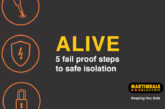
David Sweetman, Marketing & Business Development Director at Di-LOG, discusses the importance of safe isolation, Lockout and Tagout.
Every electrician with experience of working on a busy site knows how it feels to take responsibility for the other professionals around them.When you are dealing with live electricity there’s no room for calculated risks and educated guesses. The only way you can ensure your and your colleagues’ safety is by adopting adequate isolation procedures.
For electrical systems where the supply has been cut off to allow dead working, Regulation 13 of the Electricity at work Regulations 1989 applies as follows: ‘Adequate precautions shall be taken to prevent electrical equipment, which has been made dead in order to prevent danger while work is carried out on or near that equipment, from becoming electrically charged during that work if danger may thereby arise.’
This establishes a clear requirement to ensure that conductors and equipment may not be inadvertently energised. In other words, safe isolation.
In practice, this means not only cutting off the supply but also ensuring the method of disconnection is secured in the OFF position and a caution notice or label is posted at the point of disconnection.
HSE Statistics
According to the Reporting of Injuries, Diseases and Dangerous Occurrences Regulations (RIDDOR) and although it is difficult to know how many of the following statistics were caused by inadequate safe isolation, in the five years between 2017 and 2022, there were 531 non-fatal incidents and 24 fatalities reported to the HSE which were caused by contact with electricity.
The number of fatalities did drop dramatically during 2019 and 2020 due to Covid-19, however, this does translate that you have roughly a 1 in 22 chance of being fatally injured if you are involved in an electrical incident in the UK. To put this into a little more perspective, this is a dramatic difference compared to the 1 in 500 from other causes.
As well as electric shock, other electrically related injuries arise from burns, arcing and fires. Many of the injuries can take a long while to heal and often result in life-changing conditions.
Safe isolation procedures
With the 18th Edition AM2 now in full effect, safe isolation is continuing to been forced across the industry, especially by bodies such as the NICEIC and NAPIT. Although nothing has changed in the way of the testing requirement on installation test equipment, safe isolation is critical for the safety of yourself and the others around you.
The preferred method is to isolate equipment or circuits using the main switch or distribution board switch disconnector. The method of isolation should be locked off using a unique key, retained by the person carrying out the work, and a caution notice posted at the point of isolation.
Where more than one operative is working on a circuit, a multi-lock hasp can be used to prevent the operation of the main isolator until such time as all persons working on the installation have completed their work and removed their padlocks from the hasp.”The practice of placing insulating tape over a circuit breaker is not an adequate or acceptable means of securing the device in the OFF position.”
Proving dead isolated equipment or circuits
Following the isolation of equipment or circuits and before starting work, it should be proved that the area you are about to work on is in fact dead. The recommended method for doing this is by use of a test lamp or a two-pole tester (as recommended in HSE Guidance Note 38).
The test lamp or voltage detector should be proven to be working on a known live source or a proprietary proving unit. All line, neutral, and protective conductors should be tested to prove they are dead.
Electricians who regularly work on installations that have been energised should be equipped with devices for proving that conductors are dead. Di-LOG’s latest range of safety equipment for working on LV Electrical Equipment includes an array of Lockout Kits, ranging from a simple single MCB ‘PersonalLockout Kit’ for isolation of individual circuits to the industrial ‘Expert Lockout Kit’ with mostly fully insulated lockout devices for virtually all individual and main sources of energisation.
Isolate, before it’s too late!
STEP 1: Check with the user that the supply is safe to isolate.
STEP 2: Prove that your voltage indicator operates correctly with an approved proving unit.
STEP 3: Test the circuit that you are isolating is powered off by performing the following combination of checks: Line-Neutral, Line-Earth and Earth-Neutral.
STEP 4: Re-prove that your voltage indicator operates correctly with your proving unit.
STEP 5: Refit the cover on the distribution board, Lockout and Tagout.
STEP 6: Re-test again on the circuit that you are working on to confirm it is safely isolated.
Lockout Tagout (LOTO)
The Di-LOG range of ‘Lockout Kits’ are designed with safety, versatility and affordability in mind. With the entry-level DLLOC1 – Personal Lockout Kit, you get a 38mm steel padlock, a universal MCB lock, a standard ‘pins-out’ MCB lock and a warning tag.
The higher the level of the kit the more features are included. By adding items such as multiple isolation lockout hasps the kits enable multiple persons to work on the same circuit, with the ability to hold up to six lockout padlocks.
The DLLOC3 – Professional and DLLOC4 – Expert kits provide more scope to safely isolate a broader range of MCBs and main switches. Items such as the larger universal MCB lockout device, large main switch lockout device, a fully insulated padlock and hasp, ensure all commercial and industrial applications are covered.
Get more details about Di-LOG’s range of Lockout Kits here









